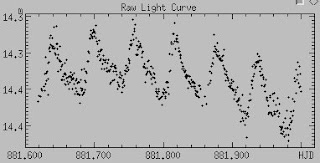Wednesday, February 25, 2009
Back in quiescence
Bob Koff has just sent me the observation indicating that RZ LMi is in quiescence at magitude of 16.7.
Sunday, February 22, 2009
End of the superoutburst?
Friday, February 20, 2009
What a coverage!
Nice superhumps again
Tuesday, February 17, 2009
Very long run
For the first time we have worked as almost Whole Earth Telescope. Below you can find the light curve combined from observations of David Boyd, Bob Koff, Kosmas Gazeas and again Bob. I still wait for the data from Pawel Kankiewicz who is observing now in Kielce and will add some points at the end of the curve.


Monday, February 16, 2009
More nice superhumps
Nice superhumps
RZ LMi in superoutburst
David Boyd (UK) reports RZ LMi being in superoutburst showing clear superhumps and overall trend still appears to be upward. Further observations strongly needed!
Saturday, February 14, 2009
Start of the superoutburst?
David Boyd reports that over approx 6 hrs last night he saw a steady rising trend from ~16.8 to ~16.5 mag. The early part of the run was through thin cloud but it then cleared. There appears to be a modulation in the data with quite a
well-defined period of 0.098 d. His nice light curve is shown below.

well-defined period of 0.098 d. His nice light curve is shown below.

Friday, February 13, 2009
Still in quiescence
Last night (HJD 875.3) Bob Koff was able to get only two images of RZ LMi and found it at 16.6 mag. Thus the star is still in quiescence.
Thursday, February 12, 2009
It was an outburst
Where are we?
Due to the gaps in the light curve the current situation of RZ LMi is uncertain. On HJD 869.3 it was at 15.9 mag, barely visible on stack of ten or so exposures obtained by Marcin Wardak during misty night. On HJD 873.3, according to David Boyd, it was at 14.9 mag. Recent data of Kosmas Gazeas show that RZ LMi is at around 16.0 mag. Most probably we saw an ordinary outburst. Thus the ingress of the superoutburst might appear very soon.
Tuesday, February 10, 2009
RZ LMi bright
David Boyd (UK) has just sent me information that he observed RZ LMi very briefly tonight at 19.00 UT during a gap in cloud cover and found it at mag 14.88 (unfiltered). No further observations have
been possible here tonight.
been possible here tonight.
Monday, February 9, 2009
Waiting for the superoutburst
I have just added the light curve obtained by Kosmas Gazeas on Feb 5/6, which nicely shows the end of the ordinary outburst. As I wrote in the earlier post, Marcin Wardak (Poland) reported that RZ LMi was in the minimum on Feb 6/7.
Now we have short break in the observations partialy due to the bad weather in almost all locations but also due to the Full Moon shinning in the vicinity of RZ LMi. But starting from this night the conditions
are getting better and I strongly encourage you to observe.
Now RZ LMi should be in the another ordinary outburst and around Feb 12-14 we should expect next superoutburst. Keep observing!
Now we have short break in the observations partialy due to the bad weather in almost all locations but also due to the Full Moon shinning in the vicinity of RZ LMi. But starting from this night the conditions
are getting better and I strongly encourage you to observe.
Now RZ LMi should be in the another ordinary outburst and around Feb 12-14 we should expect next superoutburst. Keep observing!
Saturday, February 7, 2009
RZ LMi still faint
Marcin Wardak (Poland) was observing last night. It was misty and almost Full Moon caused high brightness of sky level. RZ LMi was not visible on 180 sec exposures taken by 12-cm refractor. I am waiting for the detailed report from the observer.
Friday, February 6, 2009
RZ LMi faint
Kosmas Gazeas (Athens, Greece) was observing last night and reports RZ LMi faint sitting in quiescence. We should expect next ordinary outburst within a day or two.
Wednesday, February 4, 2009
Ordinary outburst
Newst data from Jerry Foote and Bob Koff show that RZ LMi is in the outburst again. What is interesting, the star during one night reached maximum and started to fade. It may indicate that this outburst will be much shorter than the explosion observed before superoutburst. Again, at the end of the run the small humps are visible.
Tuesday, February 3, 2009
What a light curve!
Quiescence
Data sent by Jacek Pala and obtained on nights Feb 1/2 and 2/3 clearly show that RZ LMi is now in quiescence having magnitude of around 16.5.
Sunday, February 1, 2009
End of the superoutburst
The observations from last two nights, made by Jerry Foote and Bob Koff, clearly show the end of the superoutburst. During the last night RZ LMi faded from 14.3 to 14.6 mag and amplitude of the superhumps decreased significantly. It is interesting to check the existence of the late superhumps which should born very soon.


Subscribe to:
Comments (Atom)








